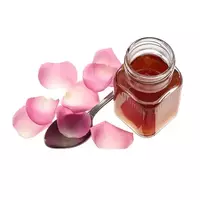Rose jam

We think most of the inhabitants of the earth know what a rose flower looks like, and the smell of a plant can be easily distinguished even by closed eyes. In nature, there are a sufficient number of wild plant species that belong to the genus Rosehip and bear the common name rose. The rose flowers we are used to acquiring in flower shops are the result of centuries of improvements and human selection work. The first roses began to be grown in ancient Rome. Roses were appreciated for their beautiful and aesthetic appearance, as well as for the intoxicating and heady aroma that enveloped the gardens of noble residents of Rome with a pink haze.
However, already in those distant times, people began to pay attention not only to the beauty of the pink flower, but also to the useful properties of the plant. Written evidence was found that pink petals, inflorescences and buds were used in ancient Babylon. This means that roses began to grow at the dawn of the development of human civilization thousands of years ago. For a long time, roses were used in cosmetics. The famous rose petal baths received by the great Cleopatra until our time excite the minds of all women on planet Earth.
Tonic and cream, elixirs, hoods, extracts and rose oil, all these components have survived to our times since ancient times and are actively used in medicine and cosmetology. However, the rose has not only excellent healing, but also taste properties. Some gourmet dishes are made using pink petals or buds. Known throughout the world and famous for its unusual thin and floral taste, rose jam. This type of dessert began to be made back in the Middle Ages. Some researchers believe that the first rose jam was prepared by the inhabitants of the East.
Over time, the delicacy of sultans, shahs and viziers migrated to Europe, namely the Mediterranean region. Currently, rose jam refers to the national sweets of France, Portugal, Spain, Italy and Turkey. Moreover, the Turkish version of rose jam bears the distinctive name gulbeseker. Jam is usually made from rose petals. However, not every variety is suitable for eating and making jam from rose petals. There are currently thousands of artificially bred rose varieties.
It is best to use the varieties Rosa gallica, Rosa ×centifolia, Rosa ×damascena and Rosa ×alba for rose jam. In ancient times, jam was made from flowers of wild varieties of roses, i. e. rose hips. To make rose jam, fresh petals are used, which are sorted and then sieved through a sieve to get rid of flower pollen. The pink petals are thoroughly washed under running water and boiled in sugar syrup. Lemon juice or acid must be added to the rose petal jam.
This ingredient helps to maintain the healthy and tasteful qualities of rose jam for longer. Often, sugar in rose jam is replaced with sorbitol, an alcohol-containing substance that has a sweet taste. The calorie content of rose jam, as well as the vitamin and mineral composition of the product, depends entirely on the variety of the plant and the conditions for growing flowers. Low-calorie and healthy rose jam is recommended to be included in the diet of diabetics, as well as people suffering from obesity.
rose jam 248 kCal
Energy value of rose jam (Ratio of proteins, fats, carbohydrates - ju):
Proteins: 0 g (~ 0 kCal)
Fats: 0 g (~ 0 kCal)
Carbohydrates: 62g (~ 248kCal)
Energy ratio (b | y): 0% | 0% | 100%
 Español
Español Français
Français Português
Português Русский
Русский 简体中文
简体中文 繁體中文
繁體中文 日本語
日本語 한국어
한국어 العربية
العربية Türkçe
Türkçe Қазақ
Қазақ Deutsch
Deutsch Italiano
Italiano Українська
Українська
